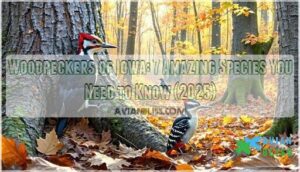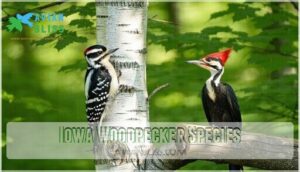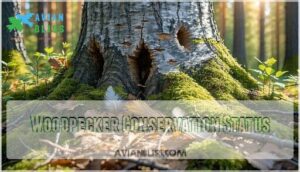This site is supported by our readers. We may earn a commission, at no cost to you, if you purchase through links.
 Iowa is home to seven fascinating woodpecker species, each adding its own rhythm to the state’s landscapes.
Iowa is home to seven fascinating woodpecker species, each adding its own rhythm to the state’s landscapes.
You’ll spot the tiny Downy Woodpecker and its larger lookalike, the Hairy Woodpecker, often drumming away on backyard trees.
The Red-headed Woodpecker, with its bold crimson head, is striking, while the Pileated Woodpecker—the largest of the bunch—is a showstopper you can’t miss.
Northern Flickers prefer feeding on the ground, while Yellow-bellied Sapsuckers sip tree sap.
And don’t confuse the Red-bellied Woodpecker’s name—it sports a red cap, not a belly!
Iowa’s woodlands are alive with their unique calls, rhythms, and colorful flight patterns.
Table Of Contents
- Key Takeaways
- Iowa Woodpecker Species
- Woodpecker Habitats Found
- Woodpecker Identification Tips
- Attracting Woodpeckers Home
- Woodpecker Conservation Status
- Frequently Asked Questions (FAQs)
- Do woodpeckers have red heads?
- What are the 7 species of woodpeckers in Iowa?
- Are there woodpeckers in Indiana?
- Where do pileated woodpeckers live in Iowa?
- Are downy woodpeckers common in Iowa?
- Are there red-headed woodpeckers in Iowa?
- What’s the difference between a flicker and a red-bellied woodpecker?
- What bird looks like a woodpecker but isn’t?
- Is it good to have woodpeckers in your yard?
- What is the largest woodpecker in Iowa?
- Conclusion
Key Takeaways
- You’ll find seven woodpecker species in Iowa, including Downy, Hairy, Red-bellied, Red-headed, Pileated, Northern Flicker, and Yellow-bellied Sapsucker, thriving in diverse habitats.
- Attract woodpeckers to your yard with suet feeders, native trees, and water sources while reducing threats like pesticides and predators.
- Habitat loss and climate change are major risks for Iowa’s woodpeckers, but preserving mature forests and dead trees helps support their survival.
- Each species has unique traits, like the Pileated Woodpecker’s size, the Red-headed’s bold coloring, and the Flicker’s ground-feeding habits.
Iowa Woodpecker Species
You’ll find seven unique woodpecker species across Iowa, each with its own fascinating traits and roles in the ecosystem.
From the tiny Downy Woodpecker to the impressive Pileated Woodpecker, these birds highlight the incredible diversity of nature in the state.
Downy Woodpecker Details
The Downy Woodpecker, Iowa’s smallest woodpecker species, boasts a Downy size of just 6-7 inches.
Iowa’s tiniest woodpecker, the Downy, measures just 6-7 inches, yet captivates with its charm and lively backyard visits.
You can spot females by their lack of a red head patch, a key woodpecker identification tip.
A common Iowa bird, they thrive in backyards, favoring suet and seeds. Attracting Iowa birds involves providing suitable feeders.
Their nesting behavior includes tree cavities, making them delightful neighbors among Iowa woodpeckers.
Hairy Woodpecker Information
The Hairy Woodpecker is one of Iowa’s striking woodpecker species. It’s larger than the Downy, with a longer beak.
These birds are easy to spot and are known for their bold behavior in woodpecker identification.
Here’s what to know:
- Lifespan: 5-10 years.
- Diet: Insects, seeds, suet.
- Behavior: Solitary yet approachable.
- Subspecies: Variations exist regionally.
Red-headed Woodpecker Features
The red-headed woodpecker, a striking woodpecker species, is recognized for its bold red plumage, sharp flycatching skills, and fascinating insect storage habits.
Found in Iowa’s savanna habitats, this bird follows unique migratory patterns.
With its vivid colors aiding woodpecker identification, this species adds charm to local landscapes while thriving on insects, seeds, and berries, showcasing its adaptability and resourcefulness everywhere.
Pileated Woodpecker Description
Standing out in Iowa’s woodpecker species, the Pileated Woodpecker is a true marvel.
Known for its striking red crest plumage, it’s the largest in the state.
You’ll often hear its loud drumming sounds echoing through forested woodpecker habitats.
With a diet preference for carpenter ants, it excavates large nest cavities, helping conservation efforts by creating shelters for other wildlife.
Northern Flicker Overview
Following the grandeur of the Pileated Woodpecker, you’ll find the Northern Flicker, a woodpecker species in Iowa with remarkable Flicker Sounds and striking looks.
Its spotted belly and yellow underwings set it apart.
Preferring open spaces, its Flicker Habitat includes fields and backyards.
Known for ground feeding, the Flicker Diet features ants and insects, while its Flicker Behavior is curious and lively.
Yellow-bellied Sapsucker Characteristics
The Yellow-bellied Sapsucker stands out among Iowa’s woodpecker species for its unique traits.
It creates Sapsucker Sap Wells in trees, a foraging method that benefits other animals too.
Key woodpecker characteristics include:
- Diet: Feeds on sap, insects, and fruits.
- Migration: Follows distinct migratory patterns annually.
- Behavior: Known for rhythmic Sapsucker Sounds and occasional tree damage, which is usually cosmetic.
Red-bellied Woodpecker Traits
After exploring the Yellow-bellied Sapsucker, you’ll love the Red-bellied Woodpecker.
This woodpecker species is known for bold patterns and vibrant vocalizations, making them standout backyard visitors.
Their Plumage Details include a red crown and neck on males, creamy undersides, and barred backs.
They’re frequent feeder guests, enjoying suet and seeds.
Their Nesting Behavior involves cavities in trees, offering needed shelter.
| Trait | Details | Notes |
|---|---|---|
| Size | 9–10 inches | Mid-sized woodpecker |
| Weight | 2–3.2 ounces | Similar to Hairy Woodpecker |
| Wingspan | 14–17 inches | Impressive in flight |
| Feeding Habits | Seeds, insects, suet | Attracted to feeders |
| Nesting Behavior | Tree cavities | Shelters backyard birds |
Woodpecker Habitats Found
You’ll find Iowa’s woodpeckers thriving in habitats like forested river corridors, deciduous woodlands, and mature forests where food and shelter abound.
Dead trees, often left behind in these areas, are perfect nesting spots and essential for their survival.
Forested River Corridors
In Iowa, forested river corridors are excellent spots for observing riverine woodpeckers.
These floodplain forests provide food, nesting spaces, and connectivity integral to Iowa ecosystems.
Their towering trees help with erosion control and water quality, supporting diverse wildlife.
Birdwatching in Iowa offers a glimpse of these habitats, where woodpeckers thrive amid the balance of nature and waterways’ steady rhythms.
Deciduous Woodlands
Deciduous woodlands in Iowa are bustling with woodpecker activity year-round.
These rich habitats, filled with mature trees, offer ideal nesting sites and a steady diet of insects and berries.
Proper woodland management guarantees these ecosystems thrive, supporting species like the Downy and Red-bellied woodpeckers.
Protecting Iowa’s forests is key for maintaining nesting ecology and preserving woodpecker diversity across these picturesque woodlands.
Mature Forests
Mature forests in Iowa are some of the best spots to see woodpeckers.
With thick canopy density and old-growth remnants, these forests support rich biodiversity. They’re perfect for species like the pileated woodpecker, which thrives among sprawling tree trunks.
Effective forest management makes certain Iowa conservation efforts protect these habitats, keeping Iowa woodlands a haven for these fascinating birds.
Some woodpeckers, like those in Texas, exhibit distinctive drumming behaviors for mating and territory.
Dead Tree Habitats
Dead tree habitats are like nature’s apartments for woodpeckers in Iowa forests.
Dead trees are nature’s condos, offering woodpeckers perfect nesting spots, abundant food, and shelter in Iowa’s thriving forests.
These decomposing ecosystems offer nesting cavities, insect abundance, and fungal growth—a buffet and shelter combo!
Woodpeckers thrive here, demonstrating wildlife dependence on these key tree habitats.
Whether it’s a mossy snag or a hollowed trunk, these spaces keep Iowa’s woodpecker species busy and your forests full of life.
Woodpecker Identification Tips
You can identify Iowa’s woodpeckers by focusing on key features like plumage colors, beak sizes, and vocal calls.
Knowing their behaviors and habitats helps you distinguish them quickly, even from a distance. Complete concepts.
Plumage and Color Patterns
Spotting plumage and color patterns makes bird identification easier.
Male vs. female woodpeckers often differ subtly, like the Downy Woodpecker’s red head spot in males.
Juvenile plumage is duller, blending in with camouflage patterns.
Redheaded Woodpeckers sport vibrant crimson heads, while the Redbellied Woodpecker’s name fits perfectly with its reddish belly.
Hairy Woodpeckers feature distinct black-and-white contrasts, beautiful and unmistakable.
Beak Shapes and Sizes
Understanding a woodpecker’s beak reveals its impressive feeding adaptations.
Their chisel-like structure, designed for drilling mechanics, allows precision in foraging.
Beak function varies by species in Iowa, reflecting evolutionary significance—like downy woodpeckers pecking into smaller crevices or pileated woodpeckers tackling deeper wood.
These unique variations highlight how evolved tools help woodpeckers thrive, shaping their ecological role and specialized feeding habits.
Tail and Wing Characteristics
Woodpecker wings and tails are built for precision flight.
In Iowa, their tail feather function is key for balance while climbing, bracing their bodies against trees.
You’ll notice wing shape variation—larger species like the Pileated excel in straight flights, while smaller ones maneuver nimbly.
Plumage aerodynamics and molting impact flight too, affecting bird size and wingspan during identification.
Some woodpeckers, like the Golden-fronted, are known to aggressively defend territory.
Vocalizations and Calls
Each woodpecker species has unique bird sounds, including drumming sounds, bird calls, and alarm calls.
Drumming replaces singing, signaling territory or mates, while alarm calls warn danger.
Some species even have regional “dialects” in their calls!
Learning these call variations helps you identify species by sound alone.
It’s like nature’s own music class—listen carefully, and you’ll hear Iowa’s woodpeckers communicating! Drumming replaces singing, alarm calls, and regional “dialects”.
Nesting Habits
Woodpeckers are like nature’s architects, carefully crafting nest cavity creation in dead trees or sturdy wood.
The average clutch size variation ranges from 3-7 eggs, with an egg incubation period of about two weeks.
They line their nests with minimal material, relying on wood chips. Fledgling development time is around a month, making Iowa’s nesting habits a fascinating bird nesting phenomenon.
Attracting Woodpeckers Home
You can attract woodpeckers to your yard by mimicking their natural habitat with plenty of food, trees, and water.
Focus on providing suet, planting native species, and creating spaces where they’ll feel safe and at home.
Setting Up Feeders
Bird feeders are perfect for attracting woodpeckers, but placement matters.
Hang your woodpecker feeder near trees for easy access.
Suet alternatives like peanut butter work well, paired with a seed variety such as sunflower or peanuts.
Use squirrel deterrents to protect food, and clean for feeder hygiene.
Suet cakes are ideal for attracting these birds.
These setups turn your yard into their favorite snack stop!
Planting Native Trees
Native trees offer big benefits for Iowa bird species, especially woodpeckers.
Visit local nurseries to find the right tree selection for your yard, focusing on species that improve soil health and provide natural habitats.
Planting techniques matter—choose well-drained soil and plant during cooler months.
You can find Iowa native tree products to help with your planting.
Trees like oaks or maples support woodpeckers while enhancing Iowa’s bird habitats with food, shelter, and nesting opportunities, which is a natural way to improve the environment.
Providing Water Sources
Adding a water source enhances your yard’s appeal to Iowa wildlife, including woodpeckers.
Bird bath options with shallow edges work well, but dripping water sources are even better for attracting backyard birds in Iowa.
Guarantee winter water access by using heated features, and clean bird baths regularly to prevent mosquito breeding.
Consider using a reliable heated option to keep water ice-free.
A simple, clean setup keeps Iowa woodpeckers returning year-round.
Creating Friendly Environment
Make your yard inviting for Iowa’s woodpeckers by reducing threats and creating cozy spaces.
Try these tips:
- Install Nesting Boxes: Perfect for backyard birds in search of shelter.
- Limit Pesticides: Protect insects they feed on.
- Plant Trees: They’ll love snags for Winter Roosting.
- Prevent Collisions: Add window decals.
- Deter Natural Predators: Keep cats indoors.
Suet Feeders and Recipes
Suet feeders are a surefire way to attract woodpeckers in Iowa.
Use homemade recipes combining suet, peanut butter, and seeds for woodpecker preferences.
Hang feeders near trees for easy access, avoiding spoilage in heat by using shade.
Consider buying suet ingredients to simplify the process.
Proper feeder placement guarantees bird feeders get visits.
Keep it simple, and you’ll see these feathered friends flocking in no time.
Woodpecker Conservation Status
You’ll find that Iowa’s woodpeckers face unique conservation challenges, including habitat loss and climate change impacts.
Understanding their status helps you protect these fascinating birds and support their survival.
Red-headed Woodpecker Status
The Red-headed Woodpecker faces challenges in Iowa, but conservation efforts are making a difference.
With eye-catching plumage, this bird captivates enthusiasts, yet struggles with population trends and habitat preservation.
Key issues include:
- Breeding success affected by competition.
- Habitat loss from land use changes.
- Migration patterns disrupted.
- Ongoing bird conservation efforts in Iowa.
- Population decline remains a concern despite progress.
Pileated Woodpecker Trends
Pileated Woodpeckers in Iowa showcase remarkable resilience, with habitat expansion and urban adaptation boosting population growth.
These woodpeckers thrive thanks to diet changes, feeding on abundant insects like emerald ash borers.
Their nesting success reflects their adaptability, benefiting birdwatching enthusiasts statewide.
As one of Iowa’s iconic bird species, they symbolize recovery and coexistence in both natural and human-altered landscapes.
Habitat Loss and Decline
In Iowa, habitat loss from forest fragmentation and urbanization impacts woodpeckers by reducing nesting sites and food sources.
Insecticide use worsens this, depleting their diets and causing bird population declines.
Conservation efforts, like preserving mature forests and limiting tree removal, are vital for woodpecker conservation.
Protecting their homes guarantees these iconic birds continue thriving amidst growing environmental pressures.
Climate Change Effects
Climate change impacts woodpeckers in Iowa by causing habitat shifts, reducing insect availability, and altering migration patterns.
Extreme weather disrupts nesting, while rising temperatures affect breeding success.
Habitat loss worsens bird population decline, leaving fewer safe havens.
These challenges highlight the need for bird conservation efforts, ensuring woodpeckers can adapt and thrive despite shifting ecosystems and unpredictable conditions in a warming world.
Woodpecker-Friendly Practices
Supporting woodpeckers in Iowa takes simple steps.
Install nesting boxes for shelter, hang suet-filled bird feeders, and limit pesticides, as natural insecticides protect their food sources.
Practice mindful tree management—allow deadwood to remain for nesting and foraging.
Avoiding deterrents like shiny objects keeps woodpeckers safe while enhancing bird attraction.
Create a welcoming habitat, and these fascinating birds will thrive.
Frequently Asked Questions (FAQs)
Do woodpeckers have red heads?
Yes, some woodpecker species, like the red-headed woodpecker and pileated woodpecker, have red heads or crests.
This vibrant coloring helps them stand out, making them easier to spot in the wild or near homes. **
What are the 7 species of woodpeckers in Iowa?
Picture a tree buzzing with life—seven woodpecker species thrive in Iowa: Downy, Hairy, Red-bellied, Red-headed, Pileated, Northern Flicker, and Yellow-bellied Sapsucker.
Each uniquely delightful, they’re either year-round residents or part-time visitors.
Are there woodpeckers in Indiana?
Indiana is home to several woodpecker species, including the Downy, Hairy, Red-bellied, Red-headed, Northern Flicker, and Pileated Woodpeckers.
You’ll often spot them in forests, backyards, and parks, especially near dead trees or feeders.
Where do pileated woodpeckers live in Iowa?
Ever wonder where you’d spot a pileated woodpecker in Iowa?
These striking birds prefer forested areas and woodlands, thriving in mature trees and dense forests where they carve their signature rectangular holes hunting insects.
Are downy woodpeckers common in Iowa?
Downy woodpeckers are widespread in Iowa, showing up year-round in backyards, parks, and wooded areas.
These tiny, energetic birds are easy to spot, often drawn to bird feeders, where they love suet and sunflower seeds.
Are there red-headed woodpeckers in Iowa?
You’ll definitely spot red-headed woodpeckers in Iowa!
These striking birds with bold crimson heads thrive in savannas, woodland edges, and pastures.
They’re known for their acrobatics and even store live insects in tree bark!
What’s the difference between a flicker and a red-bellied woodpecker?
A flicker primarily feeds on ants from the ground, while a red-bellied woodpecker eats insects, fruits, or seeds from trees.
Flickers have spotted bellies and yellow underwings, whereas red-bellied woodpeckers display zebra-striped backs.
What bird looks like a woodpecker but isn’t?
About 10% of bird species worldwide mimic woodpeckers, but one standout is the Northern Flicker.
Though woodpecker-like, it’s unique for feeding mainly on ants, often seen hopping on the ground over hammering trees. Complete concepts
Is it good to have woodpeckers in your yard?
Having woodpeckers in your yard is great for controlling insects and adding natural beauty.
They’re nature’s pest control, consuming larvae and ants while drilling harmlessly into trees.
Plus, their drumming adds a charming woodland soundtrack!
What is the largest woodpecker in Iowa?
The pileated woodpecker, stretching up to 19 inches long, is Iowa’s largest.
With its bold red crest and powerful beak, it’s like the giant of the backyard, a true head-turner among woodpeckers.
Conclusion
Much like Iowa’s ever-changing seasons, the woodpeckers of Iowa bring life and rhythm to the state’s diverse landscapes.
Whether it’s the tiny Downy Woodpecker tapping on backyard branches or the grand Pileated Woodpecker echoing through mature forests, each species has a story.
By observing their habits, calls, and vibrant colors, you’ll gain a newfound appreciation for these fascinating birds.
Protecting their habitats guarantees these feathered drummers continue to thrive across Iowa’s woodlands for future generations. Protecting their habitats guarantees these feathered drummers continue to thrive across Iowa’s woodlands for future generations.








